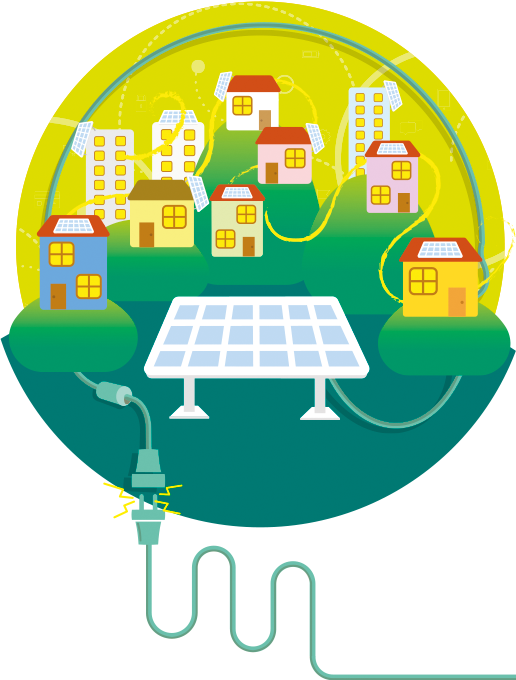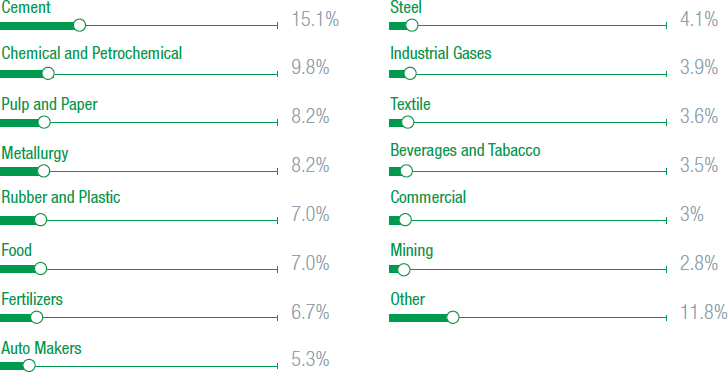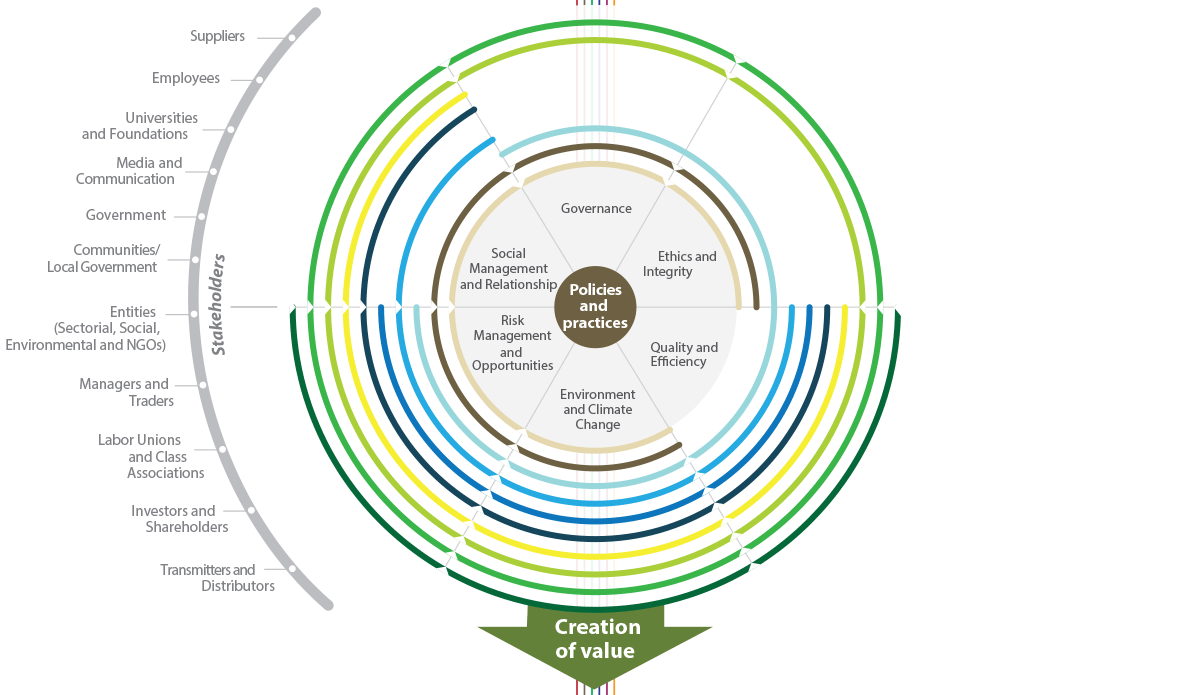Commercialization of energy GRI G4-4
Tractebel Energia sells energy in the regulated market through the intermediary of auctions, the assumption being that the price ceiling proposed by the National Electric Energy Agency – Aneel will be sufficient to ensure the feasibility of the projects developed by the Company.
Besides seeking to enhance client loyalty and the diversification of the portfolio in free market operations, Tractebel Energia endeavors to sell available energy gradually through its trading company at attractive prices and minimize the risks of exposure to prices in the short-term market (spot or Price for Settlement of Differences — PLD).
The Company seeks to diversify its client portfolio both across different industrial sectors as well as among companies in the same sector. As a result, it is possible to offset the effects of a negative scenario in given sectors or in the case of unfavorable circumstances with specific customers, so reducing the risks of revenue shortfall.
Sales are executed as and when the opportunity arises, principally when the market indicates a propensity to purchase. Operations involving the acquisition of energy for resale are also undertaken when necessary or opportune.
In 2015, free consumers represented 48.8% of the physical sales and 47.3% of net revenue from sales, equivalent to year-on-year increases of 4.8 p.p. and 6.6 p.p., respectively.
Breakdown of clients by physical sales (%)
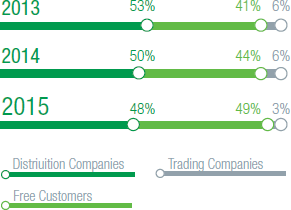
Breakdown of clients by contracted sales incorporating
net sales revenue (%)
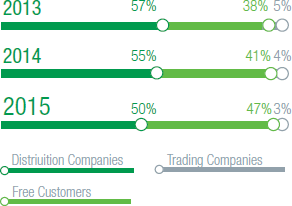
Energy Balance (average MW)
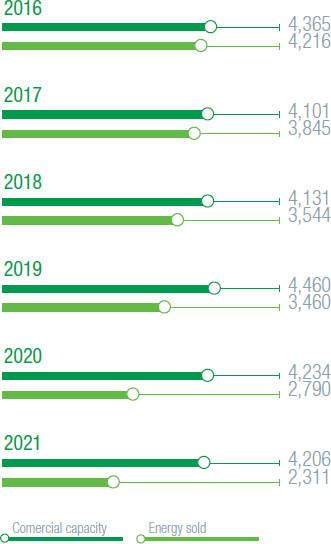
Responsible expansion of the generator complex
GRI G4-13
The installed capacity of Tractebel Energia’s generator complex has increased 89% from 3,719 MW to 7,044 MW since privatization in 1998.
Directly or through ENGIE, the Company remains alert to opportunities for expansion in different regions of Brazil, contingent however on the requisites of economic feasibility and adherence to the concept of sustainability. The Company has thus been diversifying its energy matrix and its chosen regional markets, prioritizing renewable energy sources.
From the economic and financial point of view, growth in the generator complex contributes to the longevity of the business as well as increasing revenue due to the incremental contribution to the portfolio of energy available for commercialization. Another aspect for consideration in terms of the expansion strategy is the creation of value for Brazilian society as a whole through the increased offer of available energy, improved security of the national grid system and the creation of direct and indirect employment, among other positive factors.
Tractebel Energia’s generator complex grew during the year thanks to completion in May 2015 of expansion work begun in 2014 at the Ferrari Thermoelectric Power Plant. Installed capacity was increased from 65.5 MW to 80.5 MW and physical guarantee from 23.2 MW to 35.6 average MW, adding 15 MW to the generator complex. Additionally, inclusion of the Tubarão Research and Development Wind Project in the state of Santa Catarina also contributed a further 2.1 MW. Total installed capacity as at the end of 2015 was 7,044 MW, an increase of 17 MW or 0.2% in relation to the 7,027 MW at the end of 2014. Work on the installation of the Pampa Sul Thermoelectric Power Plant in the state of Rio Grande do Sul was also started in the same period, conclusion being scheduled for the second half of 2019.
Additional installed capacity should continue to come on stream in the next few years as construction work at new plants is concluded. Below we itemize the various projects with work in progress.
In addition to these projects, Tractebel Energia has other projects at an advanced stage of development as shown in the table below.
Intangible assets
In addition to those assets incorporated in the Financial Statements, Tractebel Energia’s intangible assets also include human and intellectual capital, research, development and innovation activities and corporate image.
Human and intellectual capital
The Company is conscious of the importance of people for the sustainability of the business, promoting several programs focused on the development and retention of its professionals. In 2015, Tractebel Energia offered its employees an average of 79.5 thousand hours of training.
| Managers, coordinators and specialists |
Analysts, engineers and team heads |
Technical and operational
career personnel |
Total number of hours |
| 5,766.85 |
25,920.05 |
47,807.50 |
79,494.40 |
| |
Managers, coordinators and speciaists |
Analysts, engineers and team heads |
Technical and operational
career personnel |
Average total |
| Female |
39.56 |
47.26 |
38.23 |
42.69 |
| Male |
50.83 |
68.29 |
83.85 |
75.15 |
| Average total |
49.28 |
63.84 |
78.11 |
70.04 |
The Company has developed programs focused on the development of leaders and managers as well as running corporate education initiatives to ensure that its human capital is suitably trained. Additionally, in 2015, the Company created the Viva Retirement Program with the aim of monitoring and guiding professionals who have given years of service to Tractebel Energia. With participation optional, this Program is designed to promote information and reflection on the new routine for employees close to retirement. Legal, emotional and health related aspects are also included in the Program. GRI G4-LA10
Research, Development and Innovation (RD&I) GRI G4-DMA (formerly EU8)
Research, Development and Innovation (RD&I) projects are closely associated to the Company’s intellectual capital. The area is becoming increasingly more strategic to Tractebel Energia’s business model. Research projects are directly related to improvements in operations and the search for cleaner and more efficient sources of generating energy. Consequently, the knowledge developed from these initiatives is incorporated into the Company’s strategies.
An example of this is the 3MWp Cidade Azul Photovoltaic Plant with its 19,424 solar panels and fruit of the Aneel 013/2011 Strategic Research and Development Project. Inaugurated in 2014, the objective of the plant is to study the characteristics of this power source in the overall energy matrix, the costs involved and the performance of the installed equipment. Three different solar photovoltaic panel technologies and five inverter models at the plant are currently being tested.
The Assú and Alvorada development projects are a direct result of the value which research brings to the Company’s human, intellectual and manufacturing capital. Both projects are photovoltaic and are being installed for testing know-how in this area on a larger scale.
Under Law 9,991 of July 24, 2000, it is mandatory for generation concessionaires and independent electric energy producers to invest at least 1% of their annual net operating revenue in Research and Development (R&D) Aneel-regulated programs for the electric sector. In 2015, Tractebel Energia invested R$52.7 million in its R&D program, allocated as follows:
- R$15.1 million to the National Scientific and Technological Development Fund (FNDCT);
- R$7.6 million to the Ministry of Mines and Energy (MME), as the Company’s contribution to the funding of the Energy Research Company (EPE); and
- R$30.0 million for projects with work in progress involving aspects listed in the following table.
| Area |
Value (R$) |
| Electric energy generation |
4,072.45 |
| Safety |
36,219.57 |
| Operation of electric energy systems |
54,658.52 |
| Planning of electric energy systems |
63,204.46 |
| Strategic research |
163,405.56 |
| Thermoelectric generation |
729,128.13 |
| Environment |
1,006,313.54 |
| R&D management program |
1,209,524.47 |
| Energy efficiency |
2,018,701.23 |
| Supervision, control and protection of electric energy systems |
2,487,499.71 |
| Alternative sources of electric energy generation |
22,249,644.48 |
| Total |
30,022,372.12 |
INNOVATION AT THE
SANTA MÔNICA COMPLEX
During 2015, Tractebel also introduced innovations at the Santa Mônica Wind Complex with Eolift – French-built equipment used for lifting wind tower sections starting from those at the top and concluding with those at the base. The tower is erected by placing each new section beneath those already installed, a process which continues until the final tower height has been reached (of 120 meters). The raising of the tower and the positioning of a new section take about three hours using precision hydraulic jacks under specialized supervision. Compared with conventional methods, the new system dispenses with the need for large cranes which usually represent high costs.
Approximately R$19 million was invested during the year in an R&D project for developing and certifying a 3.3 MW capacity wind turbine. The aim of the project is to reduce the country’s technological dependence in the area and to meet the growing demand for electric energy from renewable sources.
The Company also launched the Inove program for further encouraging innovation. The program rewards innovative ideas and projects in five categories: Operation and Maintenance, Research and Development (R&D), Commercial and Business, Socio-environmental and Management. All employees are eligible to participate with the exception of managers of the organizational units and members with seats on the Innovation Committee.
This initiative is in line with ENGIE’s strategy, which believes that innovation is essential if the challenges of the world in constant mutation are to be met as well as contributing to the development of countries, companies and people. For this reason, it has launched a worldwide program of innovation to foster entrepreneurial creativity. As part of this Program, ENGIE Brasil is organizing the second edition of the ENGIE Brasil Award for Innovation open to startup companies or entrepreneurs who produce innovative commercial or technological solutions related to the following themes: decentralized energy, green mobility; energy storage; smart grids and social inclusion through energy efficiency or access to energy.
Image
Tractebel Energia’s corporate image is built and consolidated thanks to its practices and dialog with its various stakeholders. A survey conducted in 2015 by Reputation Dividend in partnership with the Attitude Group, classified the Company among the top twenty with the best reputational values in the Brazilian market. The survey shows Tractebel Energia placed 16th in the overall ranking and first among companies in the Brazilian electricity industry.
The Company’s logo – yet another important asset related to its image – was also reformulated in 2015 following the change in the parent company’s corporate denomination to ENGIE. Various initiatives in the communication field are to be taken during the course of 2016 to improve this new identity’s market penetration.


